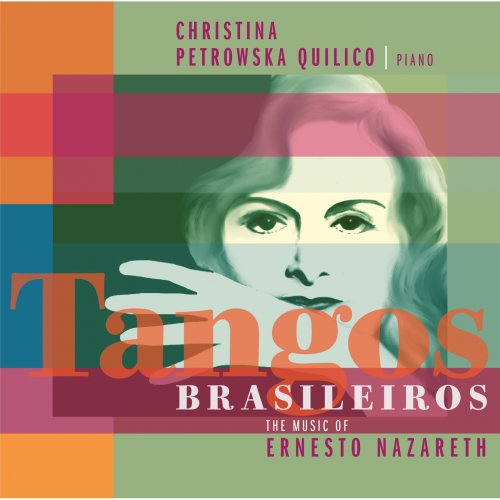
Christina Petrowska-Quilico - Tangos Brasileiros - The Music of Ernesto Nazareth (2013)
BAND/ARTIST: Christina Petrowska-Quilico
- Title: Tangos Brasileiros - The Music of Ernesto Nazareth
- Year Of Release: 2013
- Label: Marquis Classics
- Genre: Classical Piano
- Quality: flac lossless (tracks)
- Total Time: 01:36:10
- Total Size: 359 mb
- WebSite: Album Preview
Tracklist
CD1
01. Rebolico
02. Nove de Julho
03. Garoto
04. Escovado
05. Carioca
06. Fon-Fon
07. Perigoso. Tango Brasileiro
08. Matuto
09. Ranzinza
10. Ecorregando. Tango Brasileiro
11. Ouro Sobre Azul
12. Pierrot
CD2
01. Esta Chumbado
02. Myosotis
03. Brejeiro
04. Digo
05. Ferramenta. Fado Portugues
06. Odeon. Tango Brasileiro
07. Remando
08. Mandinga
09. Sarambeque
10. Ramirinho
11. Cutuba
12. Sagaz
Brazilian composer Ernesto Nazareth attempted to bring popular Brazilian dances into the concert sphere. One of these was the Argentine tango, which was all the rage during the years when he was active, on either side of 1900. He often labeled his short piano pieces "tangos brasileiros," which could indicate specifically Brazilian variants but more often was a kind of catch-all term, as ragtime became in the United States. Indeed, U.S. listeners and others interested in ragtime are likely to notice a strong similarity between a piece like Escovado (CD 1, track 4) and some of Scott Joplin's slower rags (and, of course, Joplin wrote tangos too). Recordings of Nazareth's music are not numerous, and for that reason alone this recording by Canadian pianist Christina Petrowska Quilico is to be welcomed; the question of what rhythms Nazareth was hearing and what he did with them deserves further study. All of the pieces heard here were, with the exception of one called a "fado," were indeed designated by Nazareth as tangos brasileiros. For the reasons outlined above, their rhythms vary considerably, and there's no monotony in hearing two CDs' worth of them at a sitting, even though Nazareth's music is most interesting when his various dance genres are mixed (you might not think of the polka as a Brazilian genre, but it was, and he wrote lots of them). Pianists debate how to play Joplin: should the music be kept exactly rhythmically square as written, varied slightly, or elaborated both rhythmically and melodically in the manner of a jazz pianist? The same questions apply to Nazareth, and they've just begun to be answered. Quilico hews very close to the literal end, and you may find her a trifle on the mechanical side, but this is likely to be a matter of taste. In any event, it is good to see the recorded Nazareth literature expand.
CD1
01. Rebolico
02. Nove de Julho
03. Garoto
04. Escovado
05. Carioca
06. Fon-Fon
07. Perigoso. Tango Brasileiro
08. Matuto
09. Ranzinza
10. Ecorregando. Tango Brasileiro
11. Ouro Sobre Azul
12. Pierrot
CD2
01. Esta Chumbado
02. Myosotis
03. Brejeiro
04. Digo
05. Ferramenta. Fado Portugues
06. Odeon. Tango Brasileiro
07. Remando
08. Mandinga
09. Sarambeque
10. Ramirinho
11. Cutuba
12. Sagaz
Brazilian composer Ernesto Nazareth attempted to bring popular Brazilian dances into the concert sphere. One of these was the Argentine tango, which was all the rage during the years when he was active, on either side of 1900. He often labeled his short piano pieces "tangos brasileiros," which could indicate specifically Brazilian variants but more often was a kind of catch-all term, as ragtime became in the United States. Indeed, U.S. listeners and others interested in ragtime are likely to notice a strong similarity between a piece like Escovado (CD 1, track 4) and some of Scott Joplin's slower rags (and, of course, Joplin wrote tangos too). Recordings of Nazareth's music are not numerous, and for that reason alone this recording by Canadian pianist Christina Petrowska Quilico is to be welcomed; the question of what rhythms Nazareth was hearing and what he did with them deserves further study. All of the pieces heard here were, with the exception of one called a "fado," were indeed designated by Nazareth as tangos brasileiros. For the reasons outlined above, their rhythms vary considerably, and there's no monotony in hearing two CDs' worth of them at a sitting, even though Nazareth's music is most interesting when his various dance genres are mixed (you might not think of the polka as a Brazilian genre, but it was, and he wrote lots of them). Pianists debate how to play Joplin: should the music be kept exactly rhythmically square as written, varied slightly, or elaborated both rhythmically and melodically in the manner of a jazz pianist? The same questions apply to Nazareth, and they've just begun to be answered. Quilico hews very close to the literal end, and you may find her a trifle on the mechanical side, but this is likely to be a matter of taste. In any event, it is good to see the recorded Nazareth literature expand.
As a ISRA.CLOUD's PREMIUM member you will have the following benefits:
- Unlimited high speed downloads
- Download directly without waiting time
- Unlimited parallel downloads
- Support for download accelerators
- No advertising
- Resume broken downloads


